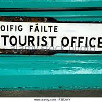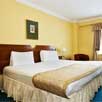Tourist attractions Galway
Galway is a perfect base for seeing West Ireland, but it is also worth a visit in itself. Although it has only a few typical sightseeing spots, what makes it a wonderful place to stay is the atmosphere, the culture, the people, and the events.
A good idea is to check local free paper the Galway Advertiser for up to date info on cultural events, concerts and plays, as well as the latest local news. Available on Thursdays it is usually snapped up very quickly.

Image: Tourist attractions in Galway, Spanish Arch
What to see
Lynch's Castle - on Shop Street is a medieval town house, now a branch of Allied Irish Banks.
The Spanish Arch - In the south west of the city at the south end of the pedestrian streets, is the Spanish Arch, one of the few remaining parts of the town's ancient defences. Walk through the arch and south west along the riverside and you will find a plaque commemorating Michael Walsh who was murdered by the Black and Tans in 1920. His dead body was dumped in the Corrib here. The park adjacent to the arch is a popular place to sit and relax, while watching the Corrib flow out into Galway Bay
The Church of Ireland St. Nicholas' Collegiate Church - is the largest medieval church still in everyday use in Ireland.[citation needed] It was founded in 1320 and enlarged in the following two centuries. It is a particularly pleasant building in the heart of the old city. Its Roman Catholic counterpart, the Cathedral of Our Lady Assumed into Heaven and St Nicholas was consecrated in 1965 and is a far larger building constructed from limestone. It has an eclectic style, with a Renaissance Revival dome, pillars and round arches, and a Romanesque Revival portico that dominates the main façade – which is an unusual feature in modern Irish church building. It was suggested by a church in the city of Salamanca in Spain.
Not far from the cathedral stands the original quadrangle building of National University of Ireland, Galway which was erected in 1849 (during the Great Famine or An Gorta Mór) as one of the three colleges of the Queen's University of Ireland (along with Queen's University Belfast and University College Cork). The university holds the UNESCO archive of spoken material for the Celtic languages.
Another of the city's limestone buildings is the Hotel Meyrick, originally the Railway Hotel and then the Great Southern Hotel, built by the Great Southern Railway Company in 1845. Sitting at the southern perimeter of Eyre Square, it is the City's oldest hotel still in operation.
The remains of Menlo Castle can be seen outside the city, on the eastern bank of the River Corrib. It was one of the ancestral homes of the Blake family, one of the Tribes of Galway from c. 1600-1910. The façade of the family's townhouse ("Blake's Castle") is still extant next to Jury's Hotel at the bottom of Quay Street.
Eglinton Canal, named after a former Lord Lieutenant of Ireland, joins the River Corrib to the sea, and flows for just more than a kilometer from the University to the Claddagh.
The Claddagh is the oldest part of Galway but little or nothing remains of its old thatched village. However, in a side altar of the parish church, St Mary's on the Hill, is the late medieval statue of Our Lady of Galway and visitors in mid-August can participate in the ancient ritual of the Blessing of the Bay, on the Sunday nearest the feast of the Assumption.
The Browne Doorway, originally located on Lower Abbeygate Street but now standing at the north end of Eyre Square, was the doorway to the townhouse of the Browne family, one of the fourteen Tribes of Galway.
The Lynch Window, (on Market Street), commemorates one of the city's most enduring legends. Here, according to legend, in 1493, the then Mayor, James Lynch FitzStephen, hanged his own son for the murder of Gomez, a young Spanish visitor who had the misfortune to befriend the girlfriend of the Mayor's son. The son, mistaking friendship for love, stabbed the Spaniard to death in a fit of jealousy and dumped his body in the River Corrib. The Mayor was both judge and executioner in the case as nobody else would carry out the execution.
The Hall of the Red Earl (Halla an Iarla Rua) can be viewed through a protective glass wall off Flood Street. It is the earliest medieval settlement fragment surviving within the walls of the city. It was built by the de Burgo family in the 13th century and was a key municipal building for the collection of taxes, dispensation of justice and hosting banquets. It was the medieval equivalent of tax office, court house and town hall.
Museums
The Galway City Museum features two parts, "Fragments of a City" and "On Reflection." "Fragments of a City"'s collection is mainly about the heritage of Galway, while "On Reflection" is a collection of the most important Irish artists from the second half of the 20th century. This museum was designed to allow tourists and local visitors to really get to understand and know the city of Galway. This museum also houses the statue of the poet, Pádraic Ó Conaire which was originally located in the Kennedy Park section of Eyre Square, prior to the Square's renovation. Visitors can also view the silver Civic Sword and Great Mace of the city at the museum.
The James Mitchell Museum of Geology in NUIG (National University of Ireland Galway) is a restored 19th century museum "within a museum".
The Computer & Communications Museum of Ireland is also housed in NUIG.
The Nora Barnacle House Museum in Bowling Green is the smallest museum in Ireland. Nora was the lover, companion and, later, wife of writer James Joyce.

















